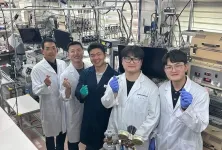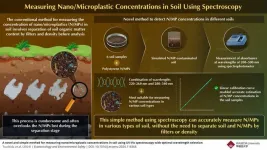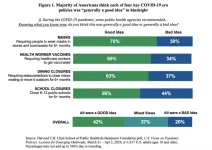(Press-News.org) Francis Crick Institute press
Peer reviewed
Experimental study
Cells, people and animals
*Case studies available for interview*
Researchers discover potential mole reversal therapy in rare condition
“Knowing there has been a huge step forward in the CMN research and there could be a chance of Ada’s CMN being reversed and possibly reducing Ada’s risk of developing melanoma, has blown our expectations out the water.” Ada’s Mum and Dad, Rachelle and Greg
Researchers at the Francis Crick Institute, UCL Great Ormond Street Institute for Child Health and Great Ormond Street Hospital for Children (GOSH) have designed a new genetic therapy that could alleviate debilitating giant moles in a rare skin condition.
In the future, the treatment could potentially be used to reverse the giant moles, and therefore reduce the risk of affected children and adults from developing cancer. It could also potentially reverse other more common types of at-risk moles as an alternative to surgery.
Small skin moles are common in the population, but in congenital melanocytic naevus syndrome (CMN), children are born with up to 80% of their body covered in big, painful or itchy moles, caused by mutations acquired in the womb. These moles can sometimes develop into a severe type of cancer called melanoma.
Published today in the Journal of Investigate Dermatology, the researchers silenced a gene called NRAS, which is mutated in the cells in these moles, in cells in a dish and in mice. NRAS belongs to a group of genes (RAS genes) that, when mutated, can cause moles, and can predispose to cancer.
The team used a genetic therapy called silencing RNA, which silences the mutated NRAS in mole skin cells. The therapy was delivered in special particles directly to mole cells.
They gave injections containing the therapy to mice with CMN, which reduced the silenced the NRAS gene after just 48 hours. They also tested it in cells and whole skin sections from children with CMN. Silencing the gene triggered the mole cells to self-destruct.
Veronica Kinsler, Principal Group Leader of the Mosaicism and Precision Medicine Laboratory at the Crick, Professor of Paediatric Dermatology and Dermatogenetics at GOSH/UCL, and NIHR Research Professor, said: “CMN is physically and mentally challenging for children and adults living with this condition and for their families. These results are very exciting, as not only does the genetic therapy trigger self-destruction of the mole cells in the lab, but we have managed to deliver it into the skin in mice. This results suggest that the treatment in future could potentially reverse moles in people, however more testing will be needed before we can give it to patients.
“We are very grateful to our patients at Great Ormond Street Hospital, who have been actively participating over many years to help us produce this new potential therapy. After more studies, we hope the therapy can soon enter clinical trials in people.”
This research was funded by the National Institute for Health and Care Research (NIHR), Caring Matters Now Charity and Patient Support Group, LifeArc and the NIHR Great Ormond Street Hospital Biomedical Research Centre.
Jodi Whitehouse, CEO of Caring Matters Now, who helped to fund the research, said: “This breakthrough in finding a treatment for CMN could transform the lives of the families we support living with CMN. As someone who was born with CMN covering 70% of my body and having undergone 30+ operations in my childhood to try and remove the CMN because of the fear of melanoma, with no success, this news is awe-inspiring and exciting. It brings real hope to the lives of those living with CMN.”
Catriona Crombie, Head of Rare Disease at LifeArc, said: "This work is part of our commitment to improving the lives of people living with rare diseases, by investing in promising research and helping scientists to overcome translational research barriers. If successful, we hope to see human clinical trials for this therapy within the next few years."
The researchers have been working closely with the Crick’s Translation team to develop the technology towards patient benefit. This has included securing translational funds from LifeArc, to carry out more research in mice to understand how the treatment works over a longer period.
Family stories
Hanna’s story
Hanna, 7, was born with a large dark lesion covering her back, stomach and thighs. Her skin is very itchy and dry with large lumpy modules making everyday life debilitating, and she can find it difficult to sleep at night. Her skin samples have been used in research like this to understand treatment options with her Mum hoping one day it will transform her quality of life.
Elijah’s story
Elijah, aged 10, was born with CMN on his scalp, which is very dry, fragile and cuts easily. He has to be monitored constantly and be very careful in the sun. In 2023 Elijah had a melanoma scare which was luckily a false alarm. His family don’t want to remove the CMN by surgery, but hope for a way to remove the risk of melanoma. They fundraise for CMN research into finding a cure.
Ada’s story
3-year-old Ada has 70% of her body covered in CMN mostly on her neck and back. Ada loves swimming and the sea, but needs to take extra precautions for her CMN which includes extra sun protection and wearing good clothing. Her CMN can also be very itchy and painful. When she was just 4 months old, she had surgery to remove some of the nodules from her back that were painful and debilitating. At that time, Ada’s parents decided to donate some of her skin cells, which have now been used in Dr Kinsler’s research.
- ENDS-
For further information, contact: press@crick.ac.uk or +44 (0)20 3796 5252
Notes to Editors
Reference: Bryant. D. et al. (2024). RNA therapy for oncogenic NRAS-driven naevi induces apoptosis. Journal of Investigative Dermatology. 10.1016/j.jid.2024.04.031.
The Francis Crick Institute is a biomedical discovery institute dedicated to understanding the fundamental biology underlying health and disease. Its work is helping to understand why disease develops and to translate discoveries into new ways to prevent, diagnose and treat illnesses such as cancer, heart disease, stroke, infections, and neurodegenerative diseases.
An independent organisation, its founding partners are the Medical Research Council (MRC), Cancer Research UK, Wellcome, UCL (University College London), Imperial College London and King’s College London.
The Crick was formed in 2015, and in 2016 it moved into a brand new state-of-the-art building in central London which brings together 1500 scientists and support staff working collaboratively across disciplines, making it the biggest biomedical research facility under a single roof in Europe.
http://crick.ac.uk/
END
Researchers discover potential mole reversal therapy in rare condition
2024-06-17
ELSE PRESS RELEASES FROM THIS DATE:
Threefold improvement of solid oxide fuel cell in 4 minutes
2024-06-17
Dr. Yoonseok Choi from the Hydrogen Convergence Materials Laboratory at the Korea Institute of Energy Research (KIER), in collaboration with Professor WooChul Jung from the Department of Materials Science and Engineering at KAIST and Professor Beom-Kyung Park from the Department of Materials Science and Engineering at Pusan National University, has successfully developed a catalyst coating technology that significantly improves the performance of solid oxide fuel cells (SOFCs) in just 4 minutes.
Fuel cells are gaining attention as highly efficient and clean energy devices driving the hydrogen economy. Among them, solid ...
New initiative aims to help tens of thousands with recurrent pericarditis
2024-06-17
DALLAS, June 17, 2024 — About 40,000 people in the United States experience recurrent pericarditis, or inflammation of the sac-like structure that protects the heart, which can cause chest pain and may lead to fluid buildup around the heart muscle.
The American Heart Association, celebrating 100 years of lifesaving service in 2024, is launching a three-year initiative to empower patients and equip health care providers with up-to-date science to inform recurrent pericarditis care decisions.
The Addressing Recurrent Pericarditis initiative, supported by Kiniksa Pharmaceuticals, aims to improve diagnosis, treatment and quality of life for those with ...
Multiple new awards recognize NCCN as exceptional source for information for cancer patients and caregivers
2024-06-17
PLYMOUTH MEETING, PA [June 17, 2024] — The National Comprehensive Cancer Network® (NCCN®) today announced new recognitions for the award-winning library of NCCN Guidelines for Patients® and NCCN Patient Webinars. The NCCN Guidelines for Patients: Colon Cancer earned a Gold Award from Hemes Creative Awards for Electronic Media/Social Media/Interactive Media/Digital Publications/Messaging. The NCCN Guidelines for Patients: Kidney Cancer earned an Award of Distinction from The Communicator Awards for Print Content—Medical. Additionally, the NCCN Patient Webinar for Uterine Cancer has been named a Gold Winner from the Viddy Awards while the NCCN Patient Webinar ...
Study shows a high-fat diet may fuel anxiety
2024-06-17
When stressed out, many of us turn to junk food for solace. But new University of Colorado Boulder research suggests this strategy may backfire.
The study found that in animals, a high-fat diet disrupts resident gut bacteria, alters behavior and, through a complex pathway connecting the gut to the brain, influences brain chemicals in ways that fuel anxiety.
“Everyone knows that these are not healthy foods, but we tend to think about them strictly in terms of a little weight gain,” said lead author Christopher Lowry, a professor of integrative physiology at CU Boulder. “If you understand that they also impact your brain in a way that ...
Novel method for measuring nano/microplastic concentrations in soil using spectroscopy
2024-06-17
Nano and microplastics are a well-known menace, found practically everywhere in nature, including soil, oceans, drinking water, air, and even the human body. Studies show that soils in particular hold a significant portion of N/MPs. The problem with these N/MPs is their microscopic size, which allows them to easily migrate through soil into the ground or freshwater bodies due to rainwater leaching. From there, they enter the human body. Hence, it is imperative to understand the distribution and movement of the soil’s N/MPs to gauge their threat and mitigate it.
Current ...
Poll: Majority of Americans say key COVID-19 policies were a good idea—but views of individual policies vary
2024-06-17
Embargoed for release: Monday, June 17, 6:00 AM ET
Boston, MA—A majority of Americans say that several key policies to stop the spread of COVID-19 were generally a good idea in hindsight, according to a new national poll by Harvard T.H. Chan School of Public Health and the de Beaumont Foundation. The poll also found, however, that views varied across policies, and many say the policies had negative impacts.
The poll, U.S. Views on Pandemic Policies: Lessons for Emerging Outbreaks, was conducted March 21 to April 2, 2024, among a nationally representative, probability-based sample of 1,017 adults ages 18 or older.
A majority of Americans say four key pandemic policies ...
Six distinct types of depression identified in Stanford Medicine-led study
2024-06-17
In the not-too-distant future, a screening assessment for depression could include a quick brain scan to identify the best treatment.
Brain imaging combined with machine learning can reveal subtypes of depression and anxiety, according to a new study led by researchers at Stanford Medicine. The study, to be published June 17 in the journal Nature Medicine, sorts depression into six biological subtypes, or “biotypes,” and identifies treatments that are more likely or less likely to work ...
Chronic high blood pressure during pregnancy doubled between 2008 and 2021 in the U.S.
2024-06-17
Research Highlights:
The number of individuals in the United States who had chronic hypertension or chronic high blood pressure during pregnancy doubled between 2008 and 2021, according to a nationwide review of private health insurance claims.
Treatment rates for chronic hypertension during pregnancy remained relatively low but stable during the same time, with only about 60% of the individuals receiving (filling prescriptions for) antihypertensive medications.
The researchers say these findings underscore the need to adhere to clinical guidelines for accurate diagnosis and treatment of high blood pressure before and during pregnancy.
Embargoed until 4 ...
Pancreatic cancer’s cellular amnesia
2024-06-17
Things aren’t always as they seem. Take pancreatic cancer, for example. In up to one in 10 cases, researchers have documented a peculiar characteristic. Some of the pancreatic cells appear to have lost their identity. It’s as if they forget what they are.
“This is very bizarre. You see pancreatic cancer, which usually somewhat resembles the original organ, losing those features and basically becoming akin to skin or esophagus—these other very unrelated tissues, " explains ...
An earthquake changed the course of the Ganges. Could it happen again?
2024-06-17
A major earthquake 2,500 years ago caused one of the largest rivers on Earth to abruptly change course, according to a new study. The previously undocumented quake rerouted the main channel of the Ganges River in what is now densely populated Bangladesh, which remains vulnerable to big quakes. The study was just published in the journal Nature Communications.
Scientists have documented many river-course changes, called avulsions, including some in response to earthquakes. However, “I don’t think we have ever seen such a big ...





